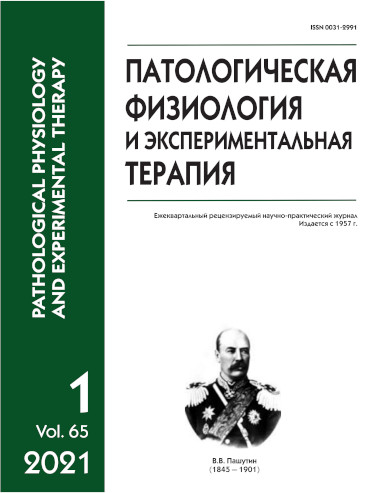Allogeneic biomaterial as an inductor of regeneration in the myocardium injured by experimental ischemia
Abstract
Introduction. Modern technologies for recovery of injured myocardium after a heart attack are not sufficiently effective and do not meet requirements for full rehabilitation of patients. Allogeneic biomaterial is a stimulator of soft tissue regeneration and has been used in various fields of medicine, including surgery, traumatology, ophthalmology, etc. The aim of this work was to study stimulation of regeneration with a biomaterial Alloplant (BMA) in the myocardium injured by experimental ischemia. Methods. This experimental study was conducted on 100 Wistar male rats weighing 0.18-0.25 kg. All animals underwent coronary occlusion by ligation of the coronary artery. In the experimental group, a saline suspension of allogeneic biomaterial (12 mg) was injected intramyocardially into the territory of the stenosed artery simultaneously with the artery ligation. In the control group of animals, a physiological solution was administered. Histological methods used in the study included light-optical microscopy for hematoxylin and eosin staining, Mallory staining, electron microscopy, and morphometry. Hearts were taken for the study at 3, 7, 14, 30, and 45 days. Results. After the BMA intramyocardial injection into the ischemic myocardium, the scar area was 68.5% smaller than in the control group, where the biomaterial was not used. In the experimental myocardium with necrotic cardiomyocytes, an area of regeneration formed, which consisted of loose fibrous connective tissue. Extensive vascularization was observed throughout the experiment. BMA particles were phagocytized by macrophages, and products of BMA biodegradation facilitated fibrogenesis. BMA exerted a cardioprotective effect and induced cell regeneration in the ischemic myocardium. In the periinfarction zone, isolated low-differentiated cells with signs of cardiomyogenic differentiation were observed. Along with young cardiomyocytes, a large amount of Anichkov cells was found. Conclusion. Intramyocardial administration of BMA reduced the scar size in myocardial infarction. Products of BMA biodegradation slowed the scar formation, exerted a cardioprotective effect, and induced cell regeneration in the myocardium injured by ischemia.
Downloads
References
2. Nepomnjashhih L.M. Pathological anatomy and ultrastructure of the heart: a Comprehensive morphological study of General pathological process in the myocardium. Novosibirsk.: Nauka. Sib. otd-nie 1981; 324р.
3. Lebedeva A.I. Allogeneic spongiform biomaterial – fibrosis inhibitor of the damaged skeletal muscular tissue. Rossijskij bioterapevticheskij zhurnal 2014; 13(4):37-44.
4. Muldashev E.R., Muslimov S.A., Musina L.A. et al. The role of macrophages in the tissues regeneration stimulated by the biomaterials. Cell Tissue Bank 2005;6(2):99-107.
5. Guidance on laboratory animals and alternative models in biomedical research. / pod red. N.N. Karkishhenko, S.V. Gracheva. M.: Profil'-2s 2010: 358р.
6. Rebrova O. Y. Statistical analysis of medical data. Application software package STATISTICA. M: Media Sphere 2002:312p.
7. Lebedevа A. I., Muslimov S. A., Musina L. A., Gareev E. M. The role of macrophages in the regeneration of skeletal muscle tissue laboratory animals, induced by the Alloplant biomaterial. Biomedicine 2014; 2: 43-50.
8. Lebedevа A. I., Muslimov S. A., Gareev E. M., Shcherbakov D. A. Morphological characteristics of macrophages and their cytokine profile in the regeneration of skeletal muscle plastic surgery allogenic spongy biomaterial. Cytokines and inflammation 2015;14 (1): 27-33.
9. Anitschkow N. Experimentelle Untersuchungen iuber die Neubildung des Granulationsgewebes im Herzmuskel. Beitr. z. path. Anat. u. z. al Ug. Path. 1912; 13(55): 373-415.
10. Anitschkow, N. Über die Rückbildungsvorgänge bei der experimentellen Atherosklerose. Verb. Dtsch. path. Ges. 1928; 23: 473–478.
11. Bolshakova G. B. Features of the appearance of the Anichkov cells in the myocardium. Bull. experimental. Biol. and med. 1984; 97(3):358-360.
12. Banin V. V. Pericytes – these are stem cells of mesenchymal origin. Morphology 2017; 3: 58.
13. Pienaar J.G., Price H.M. Ultrastructure and origin of the Anitschkow cell. Am J Pathol. 1967; 51(6):1063-1091.
14. Molina C.P., Schnadig V.J. Anitschkow nuclear changes in postmortem pericardial scrapings. Acta Cytol. 2001; 45(2): 197-200.
15. Stehbens W.E., Zuccollo J.M. Anitschkow myocytes or cardiac histiocytes in human hearts. Pathology. 1999; 31(2):98-101.






